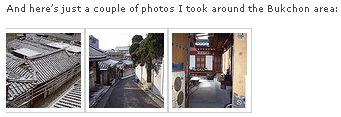
© Robert Koehler, 2005/6
Quoted from from: http://www.rjkoehler.com/?p=2502 (
Robert Koehler's "From the Nakdong
to the Yalu" Blog)
You may remember a Korea Herald piece I linked to almost two months ago
about one barbarian’s struggle to preserve the Korean hanok homes of
the Bukchon area. Well, the barbarian in question–David Kilburn–is
apparently in the hospital following a scuffle with construction workers restoring
(or destroying,
depending on your point of view) the neighborhood’s homes. This time,
however, the JoongAng Ilbo is the one to tell the tale. Read the translation
below for
a look at the debate surrounding Seoul’s attempts to renovate the Buchon
hanok village.
by Kim Ho-jeong, JoongAng Ilbo, March 3, 2006
(see the original Korean language story here )
Englishman David Kilburn (63), a former freelance journalist. He came to Korea
in 1987. Working that year as the Tokyo correspondent of an American advertising
and marketing publication, he first came into contact with Korea’s traditional
hanok houses in Seoul’s Gyedong neighborhood. In addition, he and his
Korean wife Choi Keum-ok (51) made their home in the hanok village of Seoul’s
Gahoe-dong, Jongno-gu. He said, “I fell in love with hanok as soon as
they say them.” He even wrote a piece on hanok in Wingspan, the magazine
of Japan’s ANA airline. He has been living in the same home for 19 years.
Kilburn said, “The hanok’s charm is that it’s a home keeping
nature as it is, making use of wood, stone and clay only… The hanok best
reveals the lifestyle of Koreans, who live together with nature.”
These days, Kilburn is spending time in a hospital. Opposing Seoul City’s “Embellish
Bukchon Project,” which calls for the repair and restoration of some
of the hanok in Gahoe-dong, Gyedong and Jaedong, he was hurt recently fighting
with people from reconstruction firms. “The ‘Embellish Bukchon
Project’ is, to the contrary, wrecking the hanok,” he said. In
order to stop the project, he’s been to Seoul City Hall and the Jongno-gu
Office countless times. He’s sent letters to President Roh Moo-hyun and
Seoul Mayor Lee Myung-bak asking them to suspend the project. He’s taken
pictures of construction sites and submitted them to the relevant bureaus.
He thinks that even as Seoul talks about repairing and restoring the hanok,
they are virtually destroying the basic structure of the traditional hanok.
He says that as the city repairs and restores the homes, they are replacing
the original wood and stone framework of the hanok with iron and concrete,
damaging the original form of the homes. Kilburn worries that by remodeling
the hanok in modern fashion, the city is mass producing homes that are hanok
in appearance only. Meeting with reporters on March 2, he said, “This
development without concern for the environment, which aims for 30 million
won in repair and restoration subsidies and development profits, is serious… If
the homes can even be turned into shops where you could open restaurants and
karaoke clubs, the hanok will disappear into history.”
“ In Europe, people are used to accepting discomfort to preserve palaces.
With the remodeling of hanok, repairs should be held to a minimum, and the framework
should be preserved as it was built hundreds of years ago.”
The hanok preservation debate: As word of Kilburn’s injury spreads, there
is debate over the restoration of the hanok. Hyeon Yeong-jo, the head of the
Seoul Environmental Planning Research Institute, has participated in the movement
to protect the neighborhood’s hanok’s. Hyeon expressed concern
about speculation, saying, “Since Seoul’s renovation project, the
demand has grown for non-residential hanok, while the price for hanok has climbed
1.5 times.”
There’s quite a bit of disagreement, however. Some say that since the
hanok village is not a [designated] cultural property and private property,
one can’t interfere in the repairing of homes in accordance with the
circumstances of the owners. Noh Gyeong-nae, the head of Seoul City’s
History City Preservation Team, said, “The hanok village is not ‘folk
village.’”
There is disagreement among residents. Mr. Lim (54), who has lived in Bukchon
hanok village for 35 years, said, “With the homes being reconstructed
so much, the neighborhood is losing its natural beauty… It would be best
to allow a certain amount of internal construction, while touching the exteriors
as little as possible. On the other hand, housewife Mrs. Park (47) said, “Thanks
to Seoul’s restoration project, the house prices have gone up a lot,
and previously difficult things like heating and insulation have been resolved,
so it’s satisfying.”
Bukchon: the area between the Gyeongbokgung and Changdeokgung palaces where
there is a concentration of traditional hanok homes. It’s the neighborhood
north of the Cheonggyecheon stream and Jongno. In terms of feng shui, it’s
considered the best place in Seoul. Construction of hanok in the area between
the palaces began to house members of the royal family and high officials.
The current hanok homes in the neighborhood were built during the 1930s.
Embellish Bukchon Project: A project to repair and renovate about 800 hanok
homes in about 195,000 pyeong of land in Jongno-gu’s Gahoe-dong, Samcheong-dong,
Wonseo-Dong and Jaedong, and improve the surrounding environment. The project
began in 2001 with a budget of 84.4 billion won. So far, about 240 hanok homes
have been repaired and restored. "
Translated from an article published in the Joong Ang Ilbo on March 3, 2006

© Robert Koehler, 2005/6